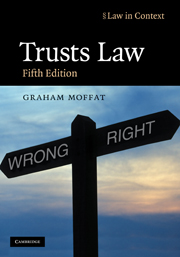Book contents
- Frontmatter
- Contents
- Preface to the fifth edition
- Acknowledgments
- Table of abbreviations
- Useful websites
- Table of statutes
- Table of statutory instruments
- Table of cases
- 1 Trusts introduced
- 2 The evolution of the private express trust
- 3 Taxation, wealth-holding and the private trust
- 4 Creating the trust – I
- 5 Creating the trust – II
- 6 Trusts and public policy
- 7 Flexibility in relation to beneficial entitlement
- 8 The taxation of private trusts
- 9 An introduction to trustees and trusteeship
- 10 Aspects of the management of trusts
- 11 Trusteeship, control and breach of trust
- 12 Implied trusts and the family home
- 13 Trusts in commerce I: occupational pension schemes
- 14 Trusts in commerce II: commerce and equitable remedies
- 15 Trusts in commerce III: commerce, credit and the trust
- 16 Trusts in commerce IV: fiduciary relationships, commerce and the trust
- 17 Trust, contract and unincorporated associations
- 18 An introduction to the law of charity
- 19 A legal definition of ‘charity’
- 20 The regulation of charities
- Index
Preface to the fifth edition
- Frontmatter
- Contents
- Preface to the fifth edition
- Acknowledgments
- Table of abbreviations
- Useful websites
- Table of statutes
- Table of statutory instruments
- Table of cases
- 1 Trusts introduced
- 2 The evolution of the private express trust
- 3 Taxation, wealth-holding and the private trust
- 4 Creating the trust – I
- 5 Creating the trust – II
- 6 Trusts and public policy
- 7 Flexibility in relation to beneficial entitlement
- 8 The taxation of private trusts
- 9 An introduction to trustees and trusteeship
- 10 Aspects of the management of trusts
- 11 Trusteeship, control and breach of trust
- 12 Implied trusts and the family home
- 13 Trusts in commerce I: occupational pension schemes
- 14 Trusts in commerce II: commerce and equitable remedies
- 15 Trusts in commerce III: commerce, credit and the trust
- 16 Trusts in commerce IV: fiduciary relationships, commerce and the trust
- 17 Trust, contract and unincorporated associations
- 18 An introduction to the law of charity
- 19 A legal definition of ‘charity’
- 20 The regulation of charities
- Index
Summary
This book seeks to present the law of trusts in a different way from conventional texts. The underlying premise is that an investigation of the social and legal contexts in which trusts commonly appear, and of the functions which trusts perform within these contexts, is an essential prerequisite to a proper understanding of trusts law. Developments that have occurred in the relevant social and legal contexts since the first edition of this book have confirmed our conviction in the value of this approach. The bulk of the book is therefore again divided into four parts: trusts and the preservation of family wealth (Chapters 3–11); trusts and family breakdown (Chapter 12); trusts and commerce (Chapters 13–16); and trusts and non-profit activity (Chapters 17–20). The new edition takes full account of the recent work of the Law Commission as well as statutory changes, including the Charities Act 2006, the Companies Act 2006 and those resulting from the Tax Law Rewrite Project, whilst the implications of the Perpetuities and Accumulations Bill 2009 are briefly introduced. Important cases, notably Stack v Dowden and Barlow Clowes International Ltd (In Liquidation) v Eurotrust International Ltd, together with an outpouring of academic literature, have all in their different ways contributed to a continuing debate about trusts law, particularly in its relationship to other areas of the common law. The effect of these influences is evident in all four parts of the book, as is the increasingly important international dimension of trusts law.
- Type
- Chapter
- Information
- Trusts LawText and Materials, pp. xix - xxiPublisher: Cambridge University PressPrint publication year: 2009



